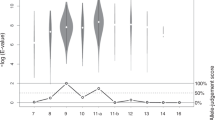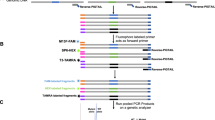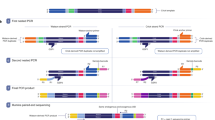Abstract
We describe a method for high-throughput typing of short tandem repeat (STR) polymorphisms. Current gel electrophoresis techniques allow only moderate throughput with long hands-on and analysis time, and the output is on a relative scale of electrophoretic mobility, prone to artifacts. Matrix-assisted laser- desorption/ionization mass spectrometry (MALDI-MS) enables an automated high throughput and delivers accurate data directly depicting the molecular nature of the analyte1. Analysis of large DNA fragments, however, is limited by adduct formation and fragmentation2,3, which result in peak broadening and low signal intensity. MALDI typing of polymorphic STRs has been reported for tri- and tetranucleotide repeats1,4,5,6 with sufficient resolution to distinguish alleles. For dinucleotide repeats, essential in animal genome studies, an enhanced resolution is necessary. Increased mass resolution was reported for RNA (ref. 7) and modified DNA (refs 8–10) due to substituents that disfavor intramolecular reactions leading to fragmentation. RNA transcripts can be synthesized enzymatically from PCR products containing a promoter sequence, requiring no specialty reagents or primer labels. Furthermore, RNA transcripts are single-stranded, a prerequisite for high-resolution mass spectrometry of nucleic acids. The 3′ heterogeneities produced by viral RNA polymerases, however, impede exact sizing of RNA runoff transcripts. Non-templated multiple-base extensions as well as premature termination have been reported7,11. PCR of dinucleotide repeats tends toward the deletion of repeat units12,13, generating a complex pattern of interleaved extensions (from RNA polymerase) and deletions (from PCR) that obscure the true allele size. We overcome this obstacle by adding a 3′ sequence encoding a catalytic RNA sequence, the so-called hammerhead ribozyme14, that cleaves itself co-transcriptionally, creating a homogeneous 3′ end.
This is a preview of subscription content, access via your institution
Access options
Subscribe to this journal
Receive 12 print issues and online access
$209.00 per year
only $17.42 per issue
Buy this article
- Purchase on Springer Link
- Instant access to full article PDF
Prices may be subject to local taxes which are calculated during checkout



Similar content being viewed by others
Change history
27 March 2018
This article was initially published with an incorrect DOI that did not match the registered version at Crossref. The DOI has been corrected in the article.
References
Braun, A., Little, D.P., Reuter, D., Muller-Mysok, B. & Koster, H. Improved analysis of microsatellites using mass spectrometry. Genomics 46, 18–23 (1997).
Nordhoff, E. et al. Ion stability of nucleic acids in infrared matrix assisted laser desorption/ionisation mass spectrometry. Nucleic Acids Res. 21, 3347–3357 (1993).
Nordhoff, E. et al. Comparison of IR- and UV-matrix-assisted laser desorption/ionization mass spectrometry of oligodeoxynucleotides. Nucleic Acids Res. 22, 2460–2465 (1994).
Ross, P.L. & Belgrader, P. Analysis of short tandem repeat polymorphisms in human DNA by matrix-assisted laser desorption/ionization mass spectrometry. Anal. Chem. 69, 3966–3972 (1997).
Ross, P.L., Davis, P.A. & Belgrader, P. Analysis of DNA fragments from conventional and microfabricated PCR devices using delayed extraction MALDI-TOF mass spectrometry. Anal. Chem. 70, 2067–2073 (1998).
Butler, J.M., Li, J., Shaler, T.A., Monforte, J.A. & Becker, C.H. Reliable genotyping of short tandem repeat loci without an allelic ladder using time-of-flight mass spectrometry. Int. J. Legal Med. 112, 45–49 (1999).
Kirpekar, F. et al. Matrix assisted laser desorption/ionization mass spectrometry of enzymatically synthesized RNA up to 150 kDa. Nucleic Acids Res. 22, 3866–3870 (1994).
Sauer, S. et al. A novel procedure for efficient genotyping of single nucleotide polymorphisms. Nucleic Acids Res. 28, 13 (2000).
Ono, T., Scalf, M. & Smith, L.M. 2′-Fluoro modified nucleic acids: polymerase-directed synthesis, properties and stability to analysis by matrix-assisted laser desorption/ionization mass spectrometry. Nucleic Acids Res. 25, 4581–4588 (1997).
Kirpekar, F. et al. 7-Deaza purine bases offer a higher ion stability in the analysis of DNA by matrix-assisted laser desorption/ionisation mass spectrometry. Rapid Commun. Mass Spectrom. 9, 525–531 (1995).
Milligan, J.F., Groebe, D.R., Witherell, G.W. & Uhlenbeck, O.C. Oligoribonucleotide synthesis using T7 RNA polymerase and synthetic DNA templates. Nucleic Acids Res. 15, 8783–8798 (1987).
Murray, V., Monchawin, C. & England, P.R. The determination of the sequences present in the shadow bands of a dinucleotide repeat PCR. Nucleic Acids Res. 21, 2395–2398 (1993).
Bovo, D., Rugge, M. & Shiao, Y.H. Origin of spurious multiple bands in the amplification of microsatellite sequences. Mol. Pathol. 52, 50–51 (1999) .
Symons, R.H. Small catalytic RNAs. Annu. Rev. Biochem. 61,641–671 (1992).
Hertel, K.J. et al. Numbering system for the hammerhead. Nucleic Acids Res. 20, 3252 (1992).
Hofacker, I.L. et al. Fast folding and comparison of RNA secondary structures. Monatshefte f. Chemie 125, 167–188 (1994).
Bishop, M.D. et al. A genetic linkage map for cattle. Genetics 136, 619–639 (1994).
Swarbrick, P.A., Howes, J. & Crawford, A.M. Ovine dinucleotide repeat polymorphism at the MAF50 locus. Anim. Genet. 23, 187 (1992).
Kossarek, L.M. et al. Rapid communication: bovine dinucleotide repeat polymorphism RM067. J. Anim. Sci. 71, 3178 (1993).
Fitzgerald, M.C., Zhu, L. & Smith, L.M. Rapid Commun. Mass Spectrom. 7, 895–897 (1993).
Acknowledgements
The authors thank K. Wild (EMBL Heidelberg) for helpful discussions. This work was realized with financial support of Tierzuchtforschung e.V. München, Arbeitsgemeinschaft Deutscher Rinderzüchter and the German Federal Department of Education, Science and Research.
Author information
Authors and Affiliations
Corresponding author
Rights and permissions
About this article
Cite this article
Krebs, S., Seichter, D. & Förster, M. Genotyping of dinucleotide tandem repeats by MALDI mass spectrometry of ribozyme-cleaved RNA transcripts. Nat Biotechnol 19, 877–880 (2001). https://doi.org/10.1038/nbt0901-877
Received:
Accepted:
Issue Date:
DOI: https://doi.org/10.1038/nbt0901-877



